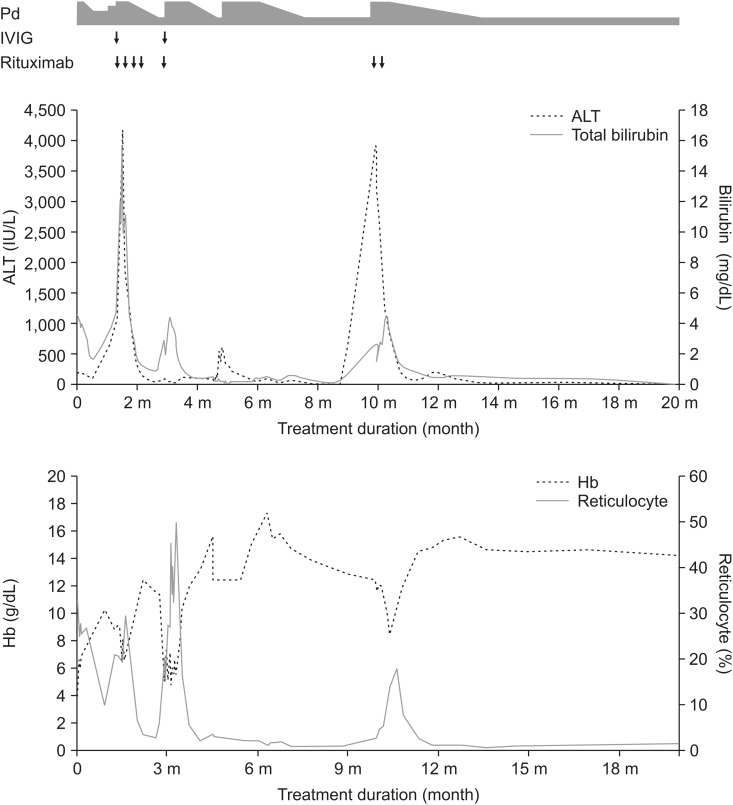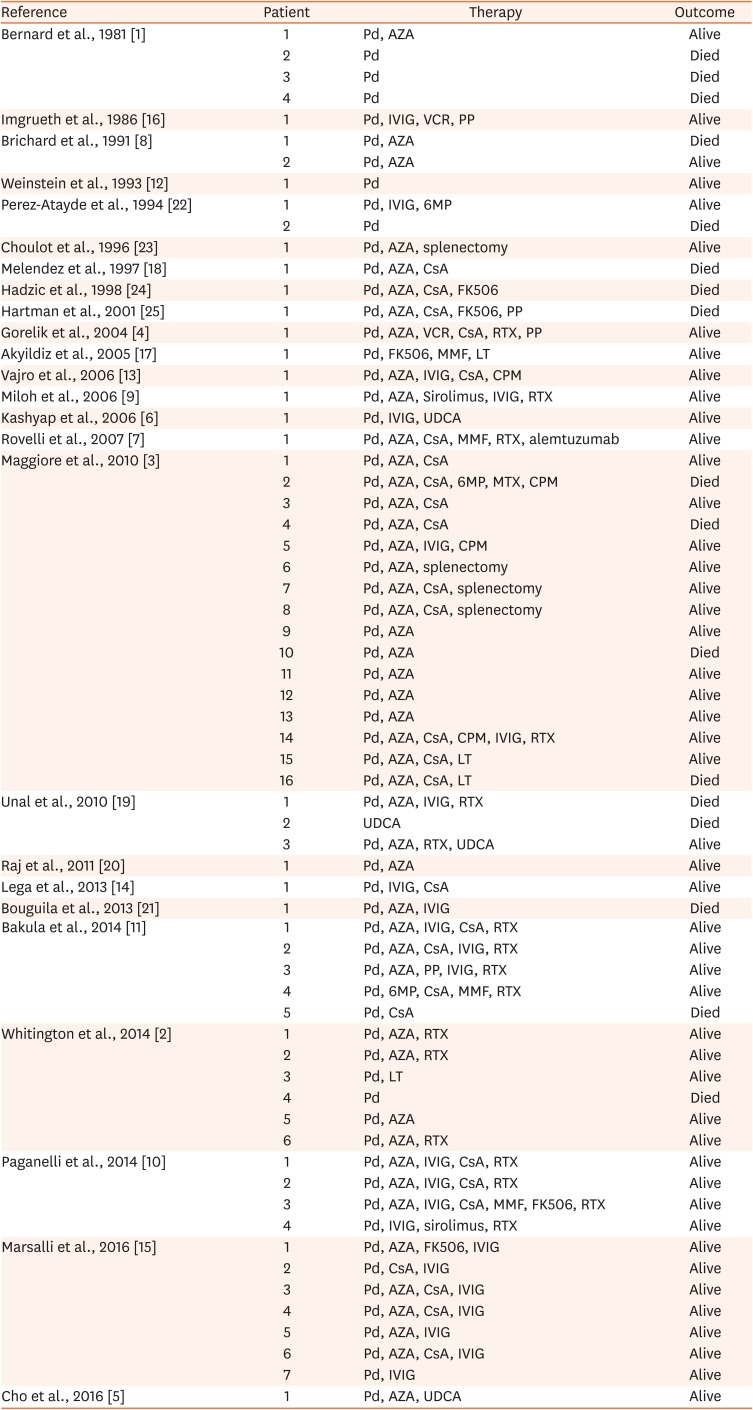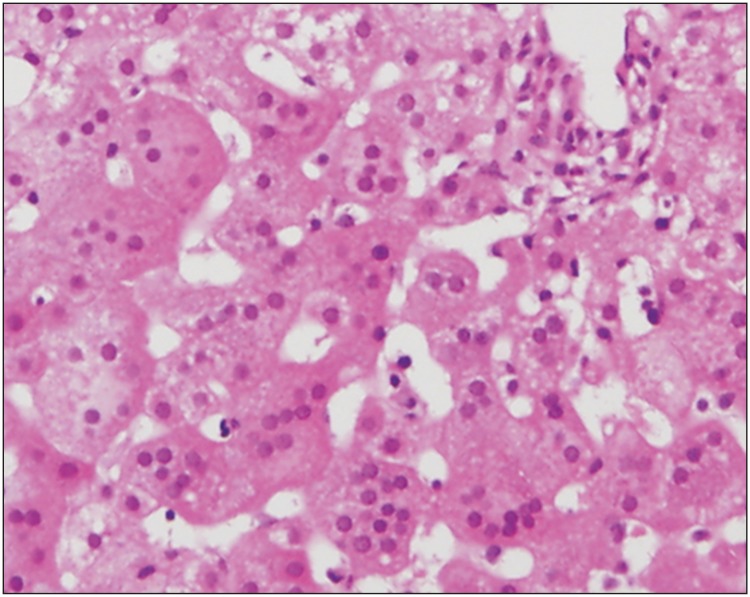1. Bernard O, Hadchouel M, Scotto J, Odièvre M, Alagille D. Severe giant cell hepatitis with autoimmune hemolytic anemia in early childhood. J Pediatr. 1981; 99:704–711. PMID:
7299542.

2. Whitington PF, Vos MB, Bass LM, Melin-Aldana H, Romero R, Roy CC, et al. Humoral immune mechanism of liver injury in giant cell hepatitis with autoimmune hemolytic anemia. J Pediatr Gastroenterol Nutr. 2014; 58:74–80. PMID:
23969541.

3. Maggiore G, Sciveres M, Fabre M, Gori L, Pacifico L, Resti M, et al. Giant cell hepatitis with autoimmune hemolytic anemia in early childhood: long-term outcome in 16 children. J Pediatr. 2011; 159:127–32.e1. PMID:
21349541.

4. Gorelik M, Debski R, Frangoul H. Autoimmune hemolytic anemia with giant cell hepatitis: case report and review of the literature. J Pediatr Hematol Oncol. 2004; 26:837–839. PMID:
15591908.
5. Cho MH, Park HS, Han HS, Bae SH. Giant cell hepatitis with autoimmune hemolytic anemia in a Korean infant. Pediatr Int. 2016; 58:628–631. PMID:
26841192.

6. Kashyap R, Sarangi JN, Choudhry VP. Autoimmune hemolytic anemia in an infant with giant cell hepatitis. Am J Hematol. 2006; 81:199–201. PMID:
16493610.

7. Rovelli A, Corti P, Beretta C, Bovo G, Conter V, Mieli-Vergani G. Alemtuzumab for giant cell hepatitis with autoimmune hemolytic anemia. J Pediatr Gastroenterol Nutr. 2007; 45:596–599. PMID:
18030239.

8. Brichard B, Sokal E, Gosseye S, Buts JP, Gadisseux JF, Cornu G. Coombs-positive giant cell hepatitis of infancy: effect of steroids and azathioprine therapy. Eur J Pediatr. 1991; 150:314–317. PMID:
2044600.

9. Miloh T, Manwani D, Morotti R, Sukru E, Shneider B, Kerkar N. Giant cell hepatitis and autoimmune hemolytic anemia successfully treated with rituximab. J Pediatr Gastroenterol Nutr. 2007; 44:634–636. PMID:
17460499.

10. Paganelli M, Patey N, Bass LM, Alvarez F. Anti-CD20 treatment of giant cell hepatitis with autoimmune hemolytic anemia. Pediatrics. 2014; 134:e1206–10. PMID:
25201797.

11. Bakula A, Socha P, Klaudel-Dreszler M, Karolczyk G, Wozniak M, Rutynowska-Pronicka O, et al. Giant cell hepatitis with autoimmune hemolytic anemia in children: proposal for therapeutic approach. J Pediatr Gastroenterol Nutr. 2014; 58:669–673. PMID:
24792633.
12. Weinstein T, Valderrama E, Pettei M, Levine J. Early steroid therapy for the treatment of giant cell hepatitis with autoimmune hemolytic anemia. J Pediatr Gastroenterol Nutr. 1993; 17:313–316. PMID:
8271134.

13. Vajro P, Migliaro F, Ruggeri C, Di Cosmo N, Crispino G, Caropreso M, et al. Life saving cyclophosphamide treatment in a girl with giant cell hepatitis and autoimmune haemolytic anaemia: case report and up-to-date on therapeutical options. Dig Liver Dis. 2006; 38:846–850. PMID:
16266839.

14. Lega S, Maschio M, Taddio A, Maggiore G, Ventura A. Giant cell hepatitis with Coombs-positive haemolytic anaemia: steroid sparing with high-dose intravenous immunoglobulin and cyclosporine. Acta Paediatr. 2013; 102:e137–9. PMID:
23205764.

15. Marsalli G, Nastasio S, Sciveres M, Calvo PL, Ramenghi U, Gatti S, et al. Efficacy of intravenous immunoglobulin therapy in giant cell hepatitis with autoimmune hemolytic anemia: a multicenter study. Clin Res Hepatol Gastroenterol. 2016; 40:83–89. PMID:
26138133.

16. Imgrueth M, Wagner HP, Pipczynski-Suter K, Beguin L, Wyss M, Pfister AM, et al. Plasma exchange: an important part of the therapeutic procedure in a small child with autoimmune hemolytic anemia. Acta Paediatr Scand. 1986; 75:1037–1041. PMID:
3564965.

17. Akyildiz M, Karasu Z, Arikan C, Nart D, Kilic M. Successful liver transplantation for giant cell hepatitis and Coombs-positive hemolytic anemia: a case report. Pediatr Transplant. 2005; 9:630–633. PMID:
16176422.

18. Melendez HV, Rela M, Baker AJ, Ball C, Portmann B, Mieli-Vergani G, et al. Liver transplant for giant cell hepatitis with autoimmune haemolytic anaemia. Arch Dis Child. 1997; 77:249–251. PMID:
9370907.

19. Ünal Ş, Kuşkonmaz B, Balamtekin N, Baysoy G, Aytaç Elmas S, Orhan D, et al. Autoimmune hemolytic anemia and giant cell hepatitis: Report of three infants. Turk J Haematol. 2010; 27:308–313. PMID:
27263748.
20. Raj S, Stephen T, Debski RF. Giant cell hepatitis with autoimmune hemolytic anemia: a case report and review of pediatric literature. Clin Pediatr (Phila). 2011; 50:357–359. PMID:
21436150.

21. Bouguila J, Mabrouk S, Tilouche S, Bakir D, Trabelsi A, Hmila A, et al. Giant cell hepatitis with autoimmune hemolytic anemia in a nine month old infant. World J Hepatol. 2013; 5:226–229. PMID:
23671728.

22. Perez-Atayde AR, Sirlin SM, Jonas M. Coombs-positive autoimmune hemolytic anemia and postinfantile giant cell hepatitis in children. Pediatr Pathol. 1994; 14:69–77. PMID:
8159622.

23. Choulot JJ, Parent Y, Etcharry F, Saint-Martin J, Mensire A. [Giant cell hepatitis and autoimmune hemolytic anemia: efficacy of splenectomy on hemolysis]. Arch Pediatr. 1996; 3:789–791. PMID:
8998533.
24. Hadzic N, Portmann B, Lewis I, Mieli-Vergani G. Coombs positive giant cell hepatitis--a new feature of Evans' syndrome. Arch Dis Child. 1998; 78:397–398.

25. Hartman C, Berkowitz D, Brik R, Arad A, Elhasid R, Shamir R. Giant cell hepatitis with autoimmune hemolytic anemia and hemophagocytosis. J Pediatr Gastroenterol Nutr. 2001; 32:330–334. PMID:
11345187.







 PDF
PDF ePub
ePub Citation
Citation Print
Print




 XML Download
XML Download